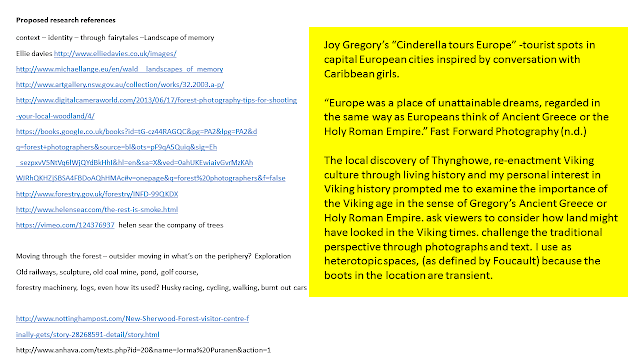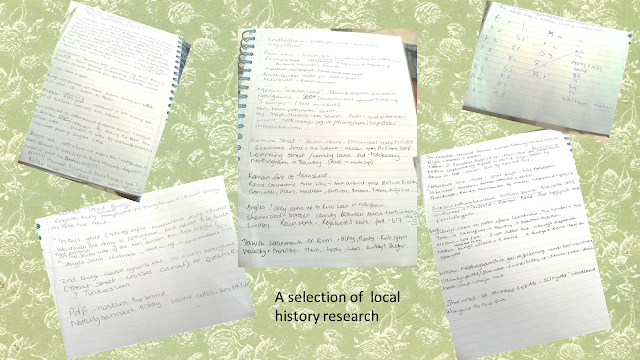April 2016
Spend an hour or so looking at photographer's artists' statements. Some will be on their own websites and most will be on the websites of the galleries which represent them. Collect a selection that interest you, noting the tone that's used and how the practitioner's inspiration and their particular use of materials are described.
Write an artist's statement to accompany your self directed project (Assignment 5) . This is not the same document as your evaluation which you should also submit as part of Assignment 5. (From OCA Course material)
Source
http://community.ucreative.ac.uk/index.cfm?articleid=18407
I came across the work of David Anthony Hall at MOVE, Southwell Minster 2016. He exhibited an artist's statement with his work.
Photographer 1 David Anthony Hall
 |
| http://www.photohall.com/David-Anthony-Hall/terms.html |
Applying the above guidelines to the reading of his artist's statement, I concluded that it was concise, effective in communicating details to the visitors of the exhibition, written in the first person and the present tense and included his motivation for making the photographic work.
Moving on to the next category, David Anthony Hall's statement explains that he is studying escapism and a search for the meaning of existence. His concept is the connection between trees and human origin, and he is exploring the ephemeral relationship with the natural and changing world.
David Anthony Hall explains his scale as being time and proportion. He is concerned with form and atmosphere, and he hints at choosing the subject based on beauty, escapism, the relationship of the natural world and to empower the trees existence.
However, reading to my exhibitions page, I recalled the artists statement being slightly different:
"He started off by explaining his work in a couple of paragraphs and then what he aimed to show. "Aimed to reveal the wonder and harmony of the natural world, producing images that emanate the very presence of nature, reminding us of its forceful past and present. By picking out every exquisite detail of form and atmosphere, my images are designed to envelope the viewer: providing a window in which to gaze and empowering an expression of their existence within the magnitude of creation." (MOVE 2015)
He then mentioned his process of leaving his photo's for a year before revisiting "with hindsight and nostalgia" (MOVE 2015)
David Anthony Hall has created the NHS Forest Scheme and along with psychologists Rachael and Stephen Kaplan, discovered as quoted by Sue Thomas that "even small glimpses of the natural world - nearby nature" could have measurable effects on wellbeing". (MOVE 2015) These benefits include a reduction in blood pressure, improve self esteem, enhance mood."
This adaptation takes the different audiences into account.
Photographer 2 Joy Gregory
My Assignment 5 project was inspired by Joy Gregory's Cinderella Tours Europe, so I looked at her artist's statement. Joy Gregory's website contains 3 sentences on this project. The Impressions Gallery Bradford produced an exhibition guide to her works which contains 3 paragraphs. There is information on the web, and by piecing it together I learnt more about her series. The Tate states there are 20 images in this collection though, and I can only find 9. This article mentions that the series was a development from earlier work so maybe the number reflects an earlier series?
 |
| http://www.joygregory.co.uk/project/cinderella-tours-europe-1998-2001/ accessed April 2016 |
In this, Joy Gregory is concise, communicates effectively, uses the present tense, takes her audience into account and states her purpose for her project. Her timescale and materials are included although she doesn't broach contextualisation, life experiences or background. These are considered in other places on the web. Joy Gregory's style is short and straight to the point.
 |
| http://www.impressions-gallery.com/_lib/_user_files/Joy%20Gregory%20Exhibition%20Guide(2).pdf accessed April 2016 |
The Impressions Gallery in Bradford which exhibited her work includes more and not written in first person but takes the audience into account. Covers the concept and scale of the project.
Other sources of information about this series of work came from the Tate Gallery and Fast Forward Photography (Women in Photography website).
The Tate mentions development work and exhibitions...
The Tate's interview mentions personality and life experiences....
and Fast Forward Photography mention photographic educational history, awards and exhibitions.
Photographer 3 Simon Roberts
 |
| http://www.simoncroberts.com/work/the-social-landscapes-of-leisure/#PHOTO_8 |
This is written in the third person, concise, informative, conceptual and where they are taken (documentation of transformed landscape) and exhibited.
So three different ways of doing things and all were effective, although if you want to know more it is probably easier to have it all in the same place. Maybe the way to do it is to generate an artist's statement relevant to the exhibition and a more general one for the website.
I did find a website which generates an artists statement for the artists which tend to be 4 paragraphs long and is a little tongue in cheek! It was good as a starting point to make a list of creative words.
My artist's statement for Assignment 5
My work for Assignment 5 examines the contemporary
landscape traversed by the Great Heathen Army in 868AD through modern day Sherwood
Forest to Nottingham.
The Viking is a metaphorical character, inspired
by Joy Gregory (photographer – Cinderella Tours Europe 1997-2001) and my own interest
in Viking history.
This series touches on documented histories
of Nottinghamshire to elucidate places known to the Vikings such as Thynghowe,
Nottingham, Sherwood Forest, Edwinstowe, Clipstone, Cuckney. Using a pair of re-enactment
boots to bridge the timespan between past and present I have illustrated the
inevitable change to the landscape brought about by man.
Sherwood Forest is famous for the legend of
Robin Hood. Contemporary archaeological evidence suggests the Vikings lived in
the local landscape and art and history is currently being reshaped with
archaeological digs and Viking sculptures.
References
http://community.ucreative.ac.uk/index.cfm?articleid=18407
http://www.photohall.com/David-Anthony-Hall/terms.html
http://www.joygregory.co.uk/project/cinderella-tours-europe-1998-2001/
http://www.impressions-gallery.com/_lib/_user_files/Joy%20Gregory%20Exhibition%20Guide(2).pdf
http://www.ualresearchonline.arts.ac.uk/1345/
http://www.tate.org.uk/context-comment/video/photography-street-and-studio-part-5-cinderella-tours-europe
http://www.fastforward.photography/gallery/cinderella-tours-europe/
http://www.simoncroberts.com/work/the-social-landscapes-of-leisure/#PHOTO_8
http://www.artybollocks.com/
(all accessed 27th April 2016)
Artists statement: In the
footsteps of the Great Heathen Army
My work examines the
contemporary landscape traversed by the Great Heathen Army who marched from York
to Nottingham in AD868, returning through Sherwood Forest and later settled alongside
Anglo-Saxons as Warrior Farmers. They were not war mongering, blood thirsty
seafarers who pillaged and plundered as depicted in popular culture.
2016 marks 1000 years
since the death of King Cnut (Canute), a Viking King, rekindling the interest
in Viking heritage. Finds from an archaeological dig (2016) will hopefully
confirm Vikings used recently discovered Thynghowe as a significant place
within the landscape. Laws made at “Thyngs” formed the basis of mediaeval law
in England.
Local tourism promotes the
idea of Robin Hood within Sherwood Forest using Foucault’s idea of a
heterotopic space (a real space which exists alongside another space at the
same time where norms of behavior become suspended), where children can pretend
to be Robin Hood or one of his Merrie Men, but walkers and local staff working
in the coffee shop and craft centre mingle with tourists. Sherwood Forest
should be a mediated space as fictional films of Robin Hood would appear to
show the Nottinghamshire landscape. However, “Robin Hood Prince of Thieves
(1991) Dir. Reynolds, shot on location in England, used other locations such as
Yorkshire, Northumberland, Wiltshire and the New Forest. Due to the rise in
social media, visiting tourists’ expectations are well informed.
Using Foucault’s view of a
heterotopic space, I positioned Viking re-enactment boots within the landscape
to signify the presence of the Viking standing in the land as a historical
character, questioning the difference between the Viking age and modern day.
The chosen landscapes have Viking connections. Photographing so that the boots
remain in sight, the angle of view on most images is fairly narrow. Shot over
the Winter and early Spring months, the undergrowth is bare so the boots remain
visible in the photograph.
With an interest in Viking
heritage tourism, I was enthused by Joy Gregory’s series, Cinderella tours
Europe”, (1998-2001). These images of tourist spots in capital European cities
are inspired by conversation with Caribbean girls where “Europe was a place of
unattainable dreams, regarded in the same way as Europeans think of Ancient
Greece or the Holy Roman Empire.” Fast Forward Photography (n.d.) Gregory,
shows images of a pair of golden shoes in different capital cities; with the
aim of recording and returning home. Continuing with the theme of Urry’s
“Tourist Gaze”, my project challenges the viewer to consider the difference
between the land now and the Viking age, updating the traditional
view of the local heritage and developing our understanding of history through re-enactment.
Nicola Hampshire (2016)


































